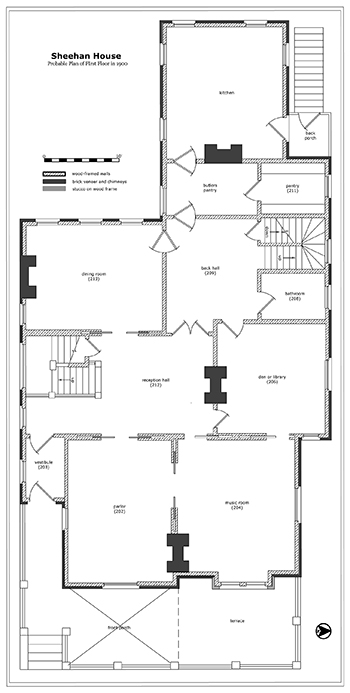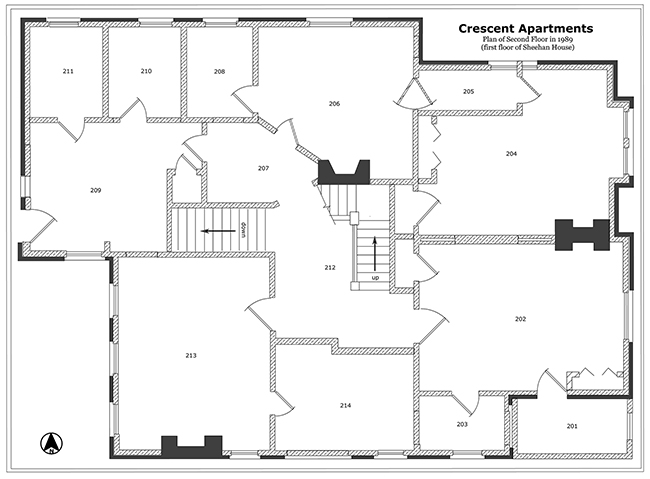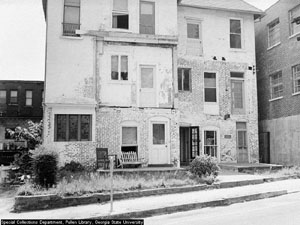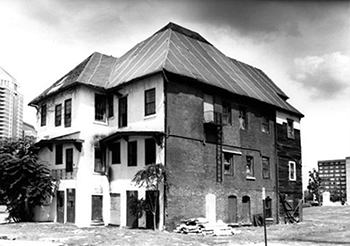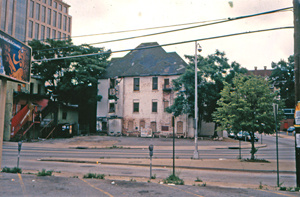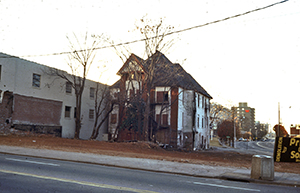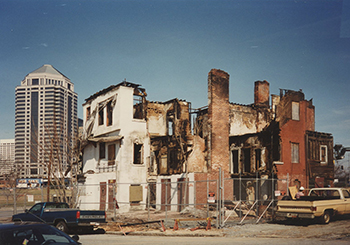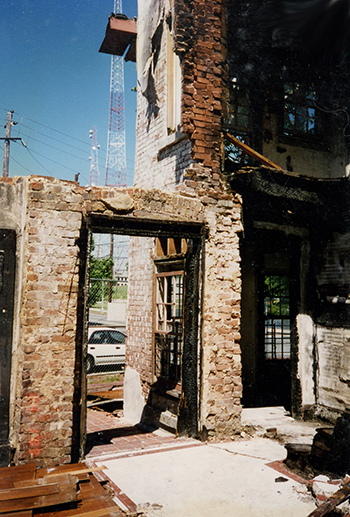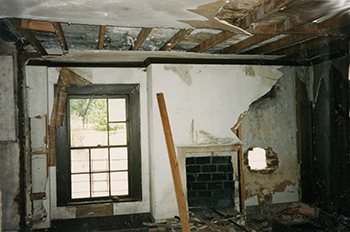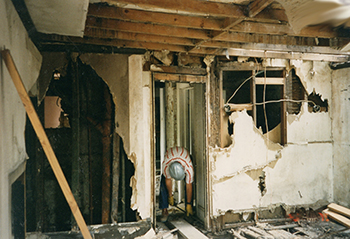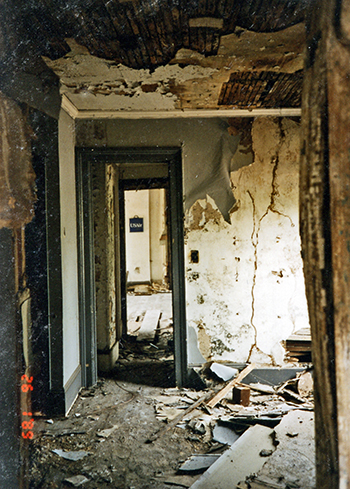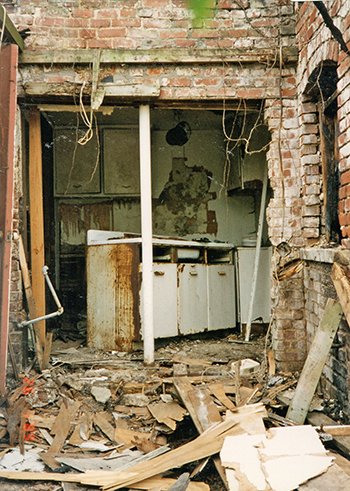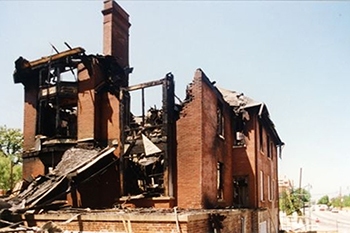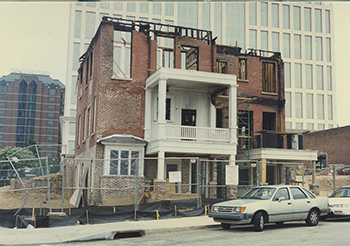What is now known as the Margaret Mitchell House was originally constructed as a single-family residence in 1899. In 1914, the building was relocated, minus its front porches, to a new ground floor that was constructed at the rear of the lot. Reoriented and known as 17 Crescent Avenue, it was converted into the ten-unit Crescent Apartments in 1919. Neglected during the Depression and World War II, the building was at least partially renovated in the late 1940s. Its condition continued to deteriorate, however, and, by 1950, apartment #1 was the only occupied unit in the building. Beginning about 1954, the building was partially occupied by commercial tenants, including a telephone answering service that operated out of the building until 1960, when the building began to again be occupied as residences. In 1964, the building was thoroughly renovated, at which time many of the historic architectural features of the building were either removed or covered up. Vacant after 1978, it burned in September 1994.
Fortunately, planning for the building’s restoration had already begun and the architectural firm of Surber and Barber completed record drawings of the existing building in May 1992. After the fire, additional building investigation by the present author, Surber & Barber, and others, including analysis of some of the building’s decorative finishes by Sara Chase, found that enough remained of the various layers of building fabric that most aspects of the building's evolution could be interpreted.
This description of the building's architectural history is a revision of earlier documents that were compiled by the author during the course of the building's restoration in the 1990s.
Original Construction, 1899-1900
Balloon-framed and sheathed with diagonally laid 1” by 8” boards, the Sheehan house was also an early example of the use of brick veneer on a wood-framed building. Generally, the framing material used construction of the house in 1899 was rough-sawn pine, between 1-¾” to 1-⅞" thick. Framing material used in the 1919 apartment conversion was not as roughly sawn and varied around 1-⅝” thick. Material for alterations after World War II was typically planed and around 1-½" thick.
The difference between the fine red brick, set in neatly struck, hard red mortar, on the upper two floors, which were constructed in 1899, contrasts sharply with the more variable brick and coarsely struck, soft yellow mortar joints of the first floor, built around 1914. Later alterations and repointing, including those in 1919, generally used portland cement-based mortars, grey in color.
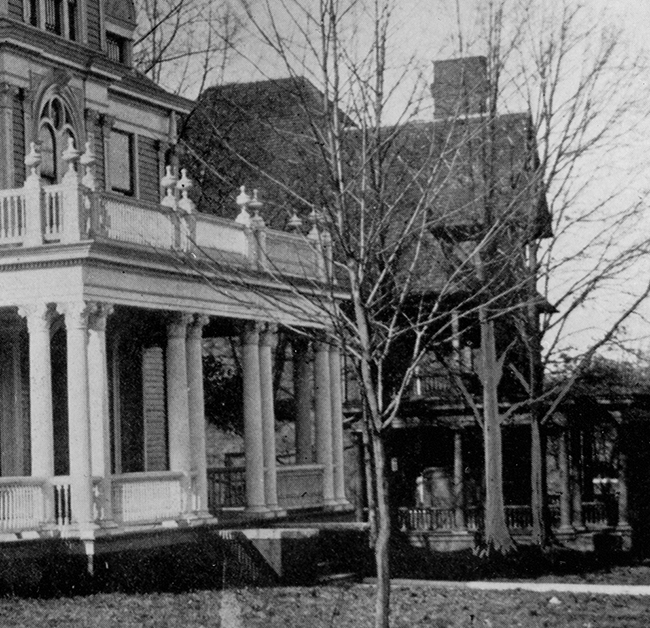
Figure 1. Detail from photograph of Emmons House with Sheehan House in the background, image included in architect Willis Denny's portfolio, c. 1903. |
The 1899 house had at least a partial basement or cellar, as evidenced by the flat arch that survives just above the level of the basement ceiling on the north facade of the building near its eastern end. Typical of the original 1899 windows on the upper floors of the building, this arch indicates the presence of an opening at the basement level of the 1899 house. The presence of a large beam across the ceiling of 102, which served as a header sill for the service stair well, indicates that the service stair also extended to the basement in the original 1899 house. The lines for gas lighting that have been located at several points in the basement may relate to lighting for the 1899 basement, for the circa 1914 basement or for both, as there is the possibility that the 1899 basement plan was replicated when the house was moved in circa 1913.
The front porch and terrace of the old Sheehan house were removed when the house was relocated in 1913. Their general outline and the fact that there was a terrace at the north end are documented by the 1911 Sanborn map. Some of the columns and balustrades are visible in the 1905 Denny photograph of the Emmons house next door, and other evidence of the configuration of the 1899 front porch survived on the east facade of the existing building. These included pockets in the brick veneer—all patched with an old lime mortar—for the porch roof rafters on both sides of the surviving bay at Room 301 and for the terrace balustrade that terminated near the north end of the east facade. Most other evidence of the original porch was lost in the 1913 move.
The two-story section of the front porch that returned down the south side of the building was retained when the building was moved. Room 201 of the building in 1994 contained the original 1899 porch floor, soffit, bed molding, and beaded tongue-and-groove ceiling. Paint ghosts from the original porch columns were visible in Room 302 above, where all but the floor of what had been the upper porch was burned away in 1994.
The two-story rear wing, which probably contained the kitchen and perhaps a servant's room for the 1899 house, was also removed in 1913. [1] Like the rest of the house, the ground or basement floor of this wing had solid brick walls, probably three wythes thick. The juncture of this wing's foundation with the foundation of the rest of the house has been excavated about four feet east of the present east facade of the building. In addition, with plaster removal on the west walls of Room 209 and Room 211, the juncture of the wing's wood-framed north wall is visible inside the Room 211 wall and that of the floor sill from the wing's south wall at the southwest corner of Room 209. This places the wing's width at about 14' and, if the relative dimensions on the Sanborn map are correct, the wing extended about 16' to the west from the rear of the main house.
Excavated with the foundation just mentioned was what appears to be the footing for a chimney of similar dimensions to the two other 1899 chimneys that were moved with the house and rebuilt on new footings in 1914. It probably served fireplaces on the west wall of Room 202 and, behind it in the service wing, what was probably a kitchen fireplace. There may also have been fireplaces in a large room under Rooms 207-211 (which includes what are now Rooms 101-105) and in the basement room of the service wing.
At least some of the building materials from this demolished wing, including the several limestone sills now at some of the basement openings, appear to have been re-used in the 1914 construction. It is also possible that the several (perhaps as many as eight or ten) windows and doors in this original wing were re-used in the construction of the new basement level in 1914.
Significant aspects of the original 1899 floor plan on what is now the second and third floor of the present building remain unknown. Even before the 1994 fire, the southwest quadrant of the building had been heavily damaged by water penetration from an open roof, the result, in part, of an earlier arson-related fire. The 1994 fire resulted in the total loss of Rooms 212, 213, 309 and 310, except for fragmentary evidence surviving on the periphery of those spaces.
Of particular interest would be the original configuration of the main staircase that rose between Rooms 212 and 309. The large window, bricked-up, that once lit this staircase was visible on the south facade of the present building until that wall collapsed after the fire. It does seem probable that the stairs rose in the south end of what became 212, although the major alterations to the east wall of that space and the loss of the remainder in the fire make exact determination of the nature of this feature impossible to ascertain.
Many houses of the period featured pocket doors between the reception hall and the surrounding formal rooms on the main floor. Pocket doors have been documented at the openings from the original reception hall of the Sheehan house, Room 212, and Rooms 204 and 213. It is also possible that pocket doors once connected Rooms 212 and 202 as well, although no evidence has been located to confirm this hypothesis. Paneled pockets do survive for tall pocket doors connecting Rooms 202 and 204.
Alterations and fire damage have also obscured the original plan in Rooms 208 and 209 and the southwest corner of Room 206. However, evidence remains of the original service stair that ran in Rooms 210 and 313 to the basement of the 1899 house. The two flanking rooms on each floor (Rooms 208 and 211, 307 and 312) appear to be part of the original plan as well, although much altered in detail.
All of the original 1899 window and door openings had flat arches in a splayed soldier course of brick and all windows had limestone sills. Many of these remain intact on the building. The original sash were probably all 1/1, although it should be noted that 1/1 was also used in some of the 1919 additions to the building.
The presence of leaded, glass panels in some of these windows has been documented. [2] The transom at the east window in Room 202, both sash in the window in Room 210, and the upper sash in Room 211 all had panels of clear glass leaded in simple geometric designs. [3] Both were probably original 1899 panels that lit the old service stairwell.
The large opening that lit the original main staircase can be identified in photographs taken before the recent fire. It, too, was probably decorated with clear or possibly stained glass panels. Note that the now-missing trio of leaded glass panels that decorated the alcove of the front room in apartment #1 also contained clear glass in a simple, geometric design. These may have originally been installed in the main stairwell or some other opening in the house before the alterations of 1919. [4]
Few specifics survive on outbuildings or landscape features that might have been on the site. The 1911 Sanborn map shows a small outbuilding near the northwest corner of the lot at Crescent Avenue. Probably a carriage house or garage, nothing is known of this building except that it was of frame construction and had a wood-shingled roof. Speculation that it might have been a privy does not seem likely since the house was almost certainly built with indoor bathrooms. If the Sanborn's location of this building is correct it stood just west of the present alcove off Room 102.
The Move, 1913–14
As noted in the historical overview, the Sheehan house was relocated in 1913–1914, and the present ground floor of the building dates to that time. The identity of the people involved with this phase of the building’s evolution have not been surely identified. One source states that the company of Clark Donaldson, a civil engineer who was later the city’s chief of construction, moved the house, but the firm’s name was not identified. In the 1910s, W. C. Pease, who had a full-page ad in the 1914 Atlanta City Directory, was one of the largest house movers the city but there were others as well. [5]
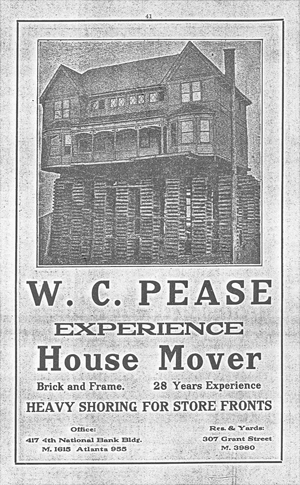
Figure 3. Advertisement from the 1914 Atlanta City Directory. |
Several small patched areas in the exterior brickwork near the chimney base in Room 124 and on the opposite north wall of Room 102 were evidence of the beams inserted under the house, including its chimneys, to support the structure while it was being moved. Once the new walls and piers had been built up to meet the old house, these beams were then removed and the holes patched. Excavation of the rear foundation of the 1899 house shows that the front facade of the relocated house was only about four feet west of the original location of the rear wall of the main block of the Sheehan house, with the service wing extending well within the footprint of the present structure. With the service wing removed along with the chimney at its east end, relocation of the house would have been a fairly simple process. Depending on the height of the original 1899 basement, which may have been as much as eight feet on the north side, the slope of the lot from Peachtree to Crescent may have even allowed for the house to be simply rolled or winched off its old foundation and onto its new foundation without having to raise the house beyond that necessary to lift it from its foundation. [6]
It is possible that apartment conversion was planned in 1913 but was thwarted by the depression of building activity following the outbreak of World War I in the fall of 1914. The absence of sewerage on Crescent until about 1919 also may have delayed conversion if it had been planned. The fact that what had been the east wall of the razed kitchen was left exposed (see 1955 photo), including its baseboard, coupled with the placement of the bottom of the fireboxes in the new basement below what became finished floor level, indicates that the initial move did not involve complete renovation of the house.
In fact, it is likely that few, if any, changes were made to the interior of the old Sheehan house when it was moved. Certainly the kitchen had to be replaced, probably in what is now Room 209. In addition, the rear service stair, which was original to the 1899 house, was probably rebuilt to the new basement in 1914. Descending from what is now Room 313 through Room 210 (plaster ghosts remained in both spaces showing the placement of the stair stringers), these stairs terminated along what is now the east side of Room102. This stairwell was lit by two windows, one between the basement and first floors and another between the first and second floors. The rough frames for both of these openings are visible in Room 102 and in Room 210 although both had been in-filled with plaster on wood lath. Both openings were bricked up on the exterior and are barely discernible there.
It is unclear where the main entrance to the building was located in 1914, when its address became 17 Crescent Avenue. Stairs rebuilt to the truncated front porch and the original front door is one possibility.[7] The tall door and transom that was at the south end of the west side of the building appears to have been, at least, a main entrance to the basement and, possibly, to the house itself. In the 1955 photograph, this opening is one of only two at the basement level that appear not to have been altered.[8] The opening on the south wall of Room 101 appears to have also been a door in 1914, although without the transom found over the door just noted above. Construction of the alcove off Room 102 in 1919 may have obscured another opening, possibly a door, at that location as well.
The Oppenheimer House, 1914–1919
When Mrs. Helen Oppenheim took title to the property in April 1914, the house, while already relocated, may not have been fully adapted from the move. A city building permit to install a furnace at 17 Crescent Avenue was issued to Mrs. Oppenheim in October 1914 and the initial finishing of the basement may have occurred during this period. Physical evidence showed that the basement or ground floor received its first interior finishes before 1919. Except as noted above, there was probably little reason to alter the upper two floors of the building prior to apartment conversion. However, a new, finished first floor would have added considerably to the value and utility of the building, especially if apartment or commercial use were contemplated.
A series of three brick walls have been identified beneath the present concrete and wood floors on the first floor. Running parallel to the south and north walls of the building, they are located on approximately ten-foot centers and may indicate the location of some of the original walls on this floor. It is more likely that they served as "shake sills" to reduce the size (and, therefore, elevate above the already close ground level) of joists for an early wood floor system. Remnants of three of these joists have been identified in the southeast corner of Room 117 and it appears that the unpainted wood floor that was found beneath the present floor of the alcove in Room 102 in 1994 is part of this 1914 floor system. That earlier floor was laid using 4"-wide, tongue-and-groove flooring.
The interior of the brick walls and piers on the ground floor were all plastered during this period and most, if not all, of the spaces had plaster-on-wood-lath ceilings. While it is clear that the first generation of existing plaster-on-wood-lath ceilings on the first floor pre-date the 1919 apartment conversion, no conclusive evidence has been located with which to date their original installation. However, it should be noted that, while there would have almost certainly been plaster ceilings in the basement rooms of the Sheehan house, these would have almost just as certainly been heavily damaged, if not completely destroyed, during the moving of the house and subsequent construction of the present first floor of the building. In addition, the plaster in the alcove, which was clearly added after construction of the exterior walls, is continuous with what remains of the plaster on the ceiling in 102. The assumption, then, is that the first generation of plaster and lath ceilings on the first floor date to 1914.
A few of the plaster on wood lath room partitions have also been definitely identified as being contemporaneous with the plaster on the brick walls, as evidenced by the pockets that remain in those walls where the original east wall of Room 110 and the wall that continued the line of the present east wall of Room 103 intersected the brick wall on the north side of the building.
The evidence suggests the possibility that parts of the present floor plan of apartment #1 were laid out in 1914. [9] However, installation of a new flooring system throughout most of the basement in 1919 would have necessitated reconstruction of any previously-existing walls, since the new floor was at least three inches higher than the old.
No evidence has survived to indicate any other finishes beyond the plastered walls and plain wood floors that seemed to characterize the pre-1919 ground floor. At the least, there would have been some interior doors requiring some casing, and there may also have been baseboards and interior window casing.
It is probable that the alcove in Room 102 was an early alteration to the first floor, perhaps as early as 1914 or 1915. The exterior brick veneer is not tied into the brick walls of the basement, indicating that the space was an addition after construction of the main walls of the ground floor. In addition, the design and construction of this space is different from the kitchen additions that were constructed above Room 111 as part of the apartment conversion in 1919. For example, the alcove is finished on the exterior with diagonal sheathing and 1” by 6” lap siding while the kitchen addition was finished with 1” by 6” beveled siding nailed directly to the stud walls. In addition, the interior plaster is contemporaneous with the ceiling that was clearly installed before creation of the 1919 floor plan. [10] Finally, soffit and fascia on the alcove are more elaborately detailed than that on the kitchen additions, although the visibility of the alcove on what was, after 1914, the main facade could account for that.
The gas lines and gas lighting locations identified in Rooms 102, 110, 117 and 120 may provide a clue to the floor plan in 1914. However, they may also be left over from lighting the basement of the Sheehan house. The presence of an early knob-and-tube wiring system has also been documented in the ceiling of the first floor and in other parts of the building. It, too, could be as early as 1899 or as late as 1914.
Crescent Apartments, 1919
Conversion of what had been a single-family residence into the ten-unit Crescent Apartments in 1919 necessitated many changes to the old Sheehan-Oppenheim house. The old first and second floors of the house were each subdivided into four apartments and two more were created at the basement level. Each of these required a bathroom and a kitchen, installation of which necessitated the most significant changes to the building.
Although the fire destroyed all evidence, it appears likely that it was at this time that the main staircase was removed from the south end of Rooms 212 and 309 as well as the old service stair between Rooms 313 and 102. In their place, a new stair, more centrally located, was built in the north end of the old stair hall with a separate staircase off the northwest side of Room 212 to the main entrance to the building in Room 106. The newel posts, including the lion post at the foot of the staircase in Room 106, and the balustrades of these staircases were probably part of the original 1899 main staircase. Other materials were re-used as well, including the service stair stringers that were utilized as sleepers under the new wood floor in Room 110.
At the south end of the old main stair hall, the large window that lit the landing of the original staircase was bricked in, new windows created on each floor and kitchens and baths installed for the apartments in the southwest corner of the building. For the apartments in the southeast corner, the old front porches were enclosed for kitchens (Rooms 201 and 302), and the vestibule (Room 203) and a dressing room or bath (Room 303) on the third floor were used for bathrooms.
For the larger, two-room apartments in the northeast corner of each floor, new bathrooms were installed in Rooms 208 and 307, locations that may have contained bathrooms in the original house. In Rooms 204 and 304, the original large windows were removed and in-filled to accommodate the much narrower windows that were removed from the short east wall of Rooms 206 and 306. The brick veneer was removed from the exterior of these walls and a frame addition constructed, measuring about 5' by 8'. With interior walls of plaster-on-wood-lath and 1” by 6” beveled siding on the exterior, these spaces contained the kitchens for these units.
For the two apartments on the northwest side of the building, the kitchens were installed in what was probably a pantry on the second floor (Room 211) and a dressing room (Room 312) on the third floor. With the old service stair removed, the two stairwell windows relocated, and a floor inserted in the stairwell space, baths were created in Rooms 210 and 313. New plaster on wood lath walls were also installed on the east side of each of these new rooms to provide a chase for water and waste lines. Behind each are remnants of the original 1899 stairwell walls.
To accommodate the new floor plan, the several pocket doors on the second floor were closed (e.g., between Rooms 202 and 204) as were some of the transomed doors (e.g., south wall of Room 306; west wall of Room 304 at the northeast corner of Room 309; and on the south wall of Room 207) and other openings on both floors. Several new door openings were also created to accommodate subdivision of the floors into apartments. The original doors in the house were 7'-4" high with two vertical panels. Some of these have survived although not necessarily in their original location or condition (see doors between Rooms 206 and 207 and between Rooms 207 and 209). The doors added in 1919 were probably all 7' high with four vertical panels (one of these doors remains in Room 305 and two more, altered, survive as the two doors on the east side of the first floor from Rooms 115 and 117.
Window and door casings for the additional openings on the second and third floor, and probably for all the openings on the first floor as well, matched the profile of the original 1899 casings in the house. It is unclear if other elements of the 1899 woodwork were replicated in 1919 although differences in the base cap throughout the second floor suggest that these less-visible features may not have been as carefully detailed as the window and door trim.
Closets were also installed in several of the original 1899 rooms on the second and third floors, including the ones that survive in the southeast corners of Rooms 202, 204 and 301. Others were added in the old entrance to Room 204 and along the east side of the old main stair hall.
Off the west side of the building, a porch was installed for each of the apartments on the west side of the second and third floors above a terrace outside each of the basement apartments. The presence of these porches is documented by the 1932 Sanborn map and 1987 sketches by Mrs. Mildred Neeson, whose family had them removed in the 1940s.
The main entrance to the new Crescent Apartments was created in the center of the west side of the first floor of the building. What may have been a window opening was enlarged to accommodate double doors, 4'-0" by 7'-4', opening into an entrance lobby (Room 106) for the entire building. These doors were replaced, probably in the 1964 renovation, although the original door frame remained intact, complete with the ghost of the street number "979" on the header. [11] Although the screen doors are visible at this opening in the 1950s photographs, the doors themselves are only barely so. On the north wall of 106, at the foot of the stairs, a simple 1’ by 8” backboard was mounted for the ten mailboxes for the building’s residents.
The sequence of flooring provides some of the most interesting clues to the evolution of the ground floor since its creation in 1914. As noted above, the entire basement was floored with 4"-wide tongue-and-groove flooring laid on a system of 2” by 6” or 2” by 8” joists. At least by 1919, this floor system, which was laid over a crawl space that was only a few inches high, may have already begun to deteriorate from termites and rot. If the joists were 2” by 6”, they might have proved inadequate even with the brick shake sills in place. Whatever the reason, the decision was made to remove the flooring, but apparently not the joists, and to fill the area with rubble to cover the joists. [12] This rubble layer includes brick, dirt and other debris that may have been related to some of the ongoing building demolition and construction in the neighborhood. It is known that a one-story, brick commercial building was constructed in 1920 at 806 Peachtree, its rear wall barely thirty feet from the east facade of the Crescent Apartments. [13]
With the fill in place, a concrete floor 2” to 3" thick was poured over most of the basement, finished at approximately the level of the original wood flooring. Tongue-and-groove flooring, 3½" wide, was then laid on 2” by 6” sleepers in most rooms. The exception appears to have been the area now encompassed by Rooms 102-105. There, perhaps because the ground was a little lower, a wood floor on joists could still be accommodated, although the original system was replaced by the present 2” by 8” joists in order to bring the floor level with the flooring laid on sleepers found in the rest of the first floor.
In the bathrooms that were created for the apartments (Rooms 105, 120, 203, 208, 210, 303, 307 and 313 have survived in part), a concrete-on-cinder-rubble base was installed and tiled with white, hexagonal, porcelain tiles, 1¼" in diameter, and a glazed ceramic tile base. In the entrance lobby to the apartment building (Room 106) and in the vestibule of apartment #1 (Room 101), the floors were tiled with white, ¾" square tiles with a 3”-wide border of red, ¾" square tiles defining the perimeter of each space.
Because wood lath was largely replaced by metal lath or plaster board in the 1930s and 1940s in Atlanta, it is assumed that all plaster-on-wood-lath walls and ceilings on the ground floor date to the 1919-1920 apartment conversion or earlier. It is possible that some of the plaster-on-wire-lath found on this floor is as early as the 1940s, but some is clearly contemporaneous with the exterior cement stucco-on-wire-lath on the exterior, which was part of the 1964 remodeling. Evidence of three ceiling finishes have been noted in the building—plaster on wood lath, plaster on wire lath, and gypsum board.
A sampling of plaster from throughout the ground floor shows at least two generations of soft lime plaster with a sand aggregate and animal hair binder applied over wood lath. Very thin (⅜" to ½") two-coat work is characteristic of both of these layers but one has a distinctive reddish cast. This reddish plaster is found in the presumably original (c. 1914) plastering of the exterior walls and piers, some ceilings, and at least one interior wall. The second lime plaster, which is found on second-generation (1919) partitions, is grey and somewhat harder than the earlier plaster. The third plaster found in the building is a modern gypsum plaster on wire lath and is presumed to date from the period after World War II. The ceiling of Room 102 and most of the walls of Room 105 are the best examples of its use. In addition, several of the ceilings in the apartment were lowered and several walls covered by 2” by 4” furring and gypsum wall board, probably in 1964. Similar alterations were made on the upper floors at the same time.
Later Renovations
Although newly renovated in 1919 and probably still in good condition while Mitchell made it her home from 1925 to 1932, the building probably suffered from lack of good maintenance as the property changed hands a number of times during the difficult economy of the 1920s. Mitchell is known to have complained about the lack of heat in her apartment which may have been the result of the hot-water heating system being either poorly designed or poorly maintained. [14] The owner who purchased the property in June 1926 defaulted on his loan and the property was sold at auction in March 1932. Five of the apartments were vacant in September 1929; by the fall of 1931, all but two were vacant. The sale of the property the following spring is probably what finally provoked the Marshes to vacate the Crescent.
The new owner, Susan King, would own the building until 1946. Some minor renovations to the building probably occurred in 1932 but that has not been documented. The fact that the apartments were fully occupied by September 1932 may simply indicate the presence of better management of the building. Typically, buildings throughout the city suffered from lack of maintenance throughout the Depression and it appears unlikely that any major work was done on the Crescent Apartments until after World War II.
Neeson Renovation, c. 1947: The next generation of building materials after 1919 includes interior plaster-on-wire-lath rather than wood lath; asbestos siding over the wood siding of the bay on the west side and of the kitchen additions on the north side; the green asbestos floor tile over the original wood floor in 110; black roll roofing over the earliest roofing and, later, green hexagonal asphalt shingles.
By 1946, the apartment building was effectively more than twenty-five years old and, according to the Neesons, in poor condition. On the Crescent facade, the porches had deteriorated to the point that they had to be removed and, with the shortage of building materials after the war, they were never rebuilt. It seems likely, however, that the Neesons did do some cosmetic repairs, including installing asbestos siding and the green hex roof. [15 ]
Nevertheless, the condition of the building continued to deteriorate and, from at least 1951 through 1953, the city directories show only apartment #1 as being occupied. With the almost wholesale commercialization of the neighborhood in the 1950s, the apartments were largely vacant through the 1950s except for one or two residents and a telephone answering service.
By the 1960s, the building began to enjoy somewhat of a renaissance as students, artists and others were offered space in the building in exchange for doing work on it. A fire detection system was installed in the building and, by 1962, it was fully occupied for the first time since the 1940s. By that time, Arthur Neeson, who was living with his mother and spinster sister at a "big, granite mausoleum of a house" at the corner of Peachtree Road and Peachtree Battle Avenue, spent most of his time with "the care and feeding of [the] apartment building . . . and he was by there daily puttering and fixing this and fixing that," according to one resident of the building in the 1960s. Considering himself "to be a patron of the arts, he would only rent to architects, architectural students, artists, and writers." [16]
Cabero Renovation, 1965: The final major renovation to the Crescent Apartments occurred in 1965, after the Neesons sold the property to Eugene D. Vezzani. His renovation of what had then become known as the "Windsor House" transformed a building in which "the roof leaked; the paint was squalid with mildew. Floors had caved, bathrooms had fallen in, termites had taken over." Amid one of the city's periodic campaigns to enforce building code compliance, there were those who said the building should be torn down and that it was "a ruin." Instead, the Windsor House was described as having been "rebuilt, outside and in." Perhaps generous in her description of Vezzani's renovation, the author went on to mention that "it has gardens, sculpture, gaslights, touches of the Italian palazzo and the Swiss chalet." [17] Prior to the 1994 fire, the vaguely chalet-like pent roofs on the west facade of the building were one of its most prominent features. Other changes related to the Vezzani renovation are readily identified by the use of gypsum board; plywood paneling; metal, spring-loaded window tracks; and other modern materials.
Among the most significant alterations to the building during this period was the installation of concrete stucco on wire lath across the entire west facade of the building. The pent roofs were then installed above the openings across the second floor. Many of the building's windows were rebuilt and new sash installed and many of the old doors, including those at the main entrance, were replaced.
On the interior, most of the bathrooms and kitchens were remodeled and a number of dry-walled alterations were made throughout the building. These included the expansion of apartment #1 into the area occupied by Rooms 112-117.
The Fires, 1994 and 1996
Preceding the disastrous 1994 fire, the Crescent Apartments had been subjected to many years of neglect. In the course of the preceding fifteen years, the building had stood vacant and most of the significant architectural details had been stripped out of the building. The failed roof covering, which had probably been installed in the 1940s and repaired but not replaced in the 1960s, allowed substantial water damage to the interior, including the loss of most of the floors and ceilings in the southwest corner of the structure. The kitchen additions on the north side of the building were also largely lost during this period.
In September of 1994, as part of the Piedmont Arts Festival, the decayed building was used as a prop for an art installation which consisted of hundreds of inflated surgical gloves covered the roof of the building. On the festival’s opening day, September 17, a fire was set in the southwest corner of the second floor, destroying the entire roof system and front gable of the building and leading to collapse of the exterior brick walls down to ground level on parts of the south side. In addition, the walls to the basement ceiling level on the south half of the west side and around the north bay on the east side were unstable and had to be taken down shortly after the fire. Completely destroyed, either through neglect or fire, were rooms Rooms 123, 212 and the space beyond to the south wall, 213, 309, and 310. Only fragmentary evidence survives from Rooms 106, 107, 111, 122 and 124.
However, the rooms on the north side of the building on all three floors survived largely intact as did most of the rooms in the southeast corner. Rooms 101, 119–121, 201–204, 206, 207, 209 and 301–312 were heavily damaged but not destroyed. Rooms 102-110, which includes most of historic Apartment #1; 112–117; 208; 210; and 211 were largely undamaged by fire although water damage was substantial.
In spite of the near-complete destruction of the house, plans for restoration became plans for reconstruction, which began in 1995. That work was nearly complete when, improbably, the house was torched again in May 1996, destroying most of the house for a second time. Once again, Apartment #1 largely escaped damage. The house was heavily insured, and a second reconstruction began almost immediately.
Notes on Infrastructure
The turn of the century was a period during which new technologies were beginning to alter residential building design and construction. Evidence of many of these early building utility systems were found throughout the building in 1994.
Water and Sewerage: With an expanding sewer and water system in the late nineteenth century, increasing numbers of Atlantans were beginning to enjoy the convenience of indoor plumbing, with a single bath per household being the rule. At the same time, multiple indoor bathrooms were beginning to appear in the homes of the wealthy. Rhodes Hall, for example, had three and a half baths as part of its original design in 1902.
Water and sewerage were probably part of the original construction of the Sheehan house in 1899, although the best evidence for that was lost when the kitchen/service wing was razed in 1913. No evidence in the existing structure has been located to confirm the presence of bathrooms in the 1899 house but Rooms 208 and 307 could both have easily served that purpose.
The city directories 1913-18 state that Crescent Avenue had sewerage "between 11th and 12th," implying that there was no sewerage the rest of its length, including the block between Tenth and Peachtree Place, prior to 1919. While it might have been possible to reconnect to the Peachtree Street sewer any waste lines on the second and third floor of the building after it was moved, that might not have been possible for any plumbing that might have been contemplated for the first floor. It seems likely that most of the present primary waste lines in the building were installed as part of the apartment conversion in 1919, about the same time that sewer service reached this block of Crescent.
After 1919, the building had ten bathrooms (in Rooms 105, 120, 203, 208, 210, 303, 307, 313, and one on each floor in the southeast corner of the old main stairwell) and ten kitchens (in Rooms 110, 118, 201, addition off 205, 211, 302, addition off 305, 312, and probably one on each floor in the southwest corner of the old stairwell). The second bathroom (Rooms 112–114) for apartment #1 was probably added in 1964 when Room 117 was finished as a second bedroom for apartment #1. Except for the pre-1919 floor plan itself, which could easily have accommodated bathrooms at several locations, no sure evidence of bathrooms prior to 1919 has been located. It is possible that, as with the interior woodwork, the design and style of the 1919 bathrooms included features from the 1899 baths. More likely, except for possibly woodwork, all existing bathrooms were completely overhauled in 1919.
A large cast-iron tank stood in the southeast corner of Room 115 and was probably part of a water-heating system installed in 1919. The tank, which had been reinforced by steel bands, has a large vertical crack on the northwest side. Note that all water supply lines were run in galvanized pipe; hot water heating (see below) lines were run in a larger cast iron. In 1994, ten sets of piping for gas ran across the ground floor ceiling from the gang of meters that on the northeast corner of the building.
All of the bathrooms were probably finished with the similar materials. This included white porcelain, hexagonal floor tiles, 1-¼" diameter, that still remains in most of the bathrooms, and white ceramic tile base tiles, 6" by 6", with ¾" white ceramic tile quarter round at top, no cove at bottom and found in fragments in some bathrooms. Also common to the bathrooms was a plaster dado scored to resemble 3" by 6" rectangular tiles topped with a 4" three-part wooden chair-rail, which survives in fragments in several areas, including Room 105. Upper walls and ceiling were smooth-finished plaster on wood lath.
Footed tubs, wall-mounted (but not necessarily high tank) toilets, and probably wall-mounted sinks would have been typical of the period and of the fixtures present. Kitchen fixtures were probably limited to wall-hung, porcelain-on-cast-iron sink and drain board. Some of the historic plumbing fixtures in the building were probably removed after World War II; all others were removed in 1964, except for the toilet in 313. With wall-hung tank connected to the bowl by a chromed elbow, this undated toilet is typical of the period. Although the bowl was broken, the fixture was repaired and reinstalled to replace the missing toilet in 105.
Heating and ventilation: Coal-burning fireplaces were perhaps the most common method of home heating in Atlanta in the late 19th and early twentieth centuries. Other heating technologies were being used, however, including hot air (but not forced air), steam, and, less commonly, hot water. In many cases, coal-burning fireplaces were included along with more-modern heating systems, as at Rhodes Hall which had coal-burning fireplaces in most rooms and a steam heating system for the main floor, the second-floor bathrooms and the third-floor billiard room. Most houses built in Atlanta prior to World War I followed this pattern.
In 1899, the Sheehan House included a number of fireplaces, probably all coal-burning. These were certainly in Rooms 202, 204, 206, 213, 301, 304, 306, 310, and probably at the north end of the reception hall (Room 212) as well. There is no evidence of fireplaces in Rooms 207–211 or 307–313 although there were probably fireplaces in the kitchen/service wing behind. What appear to be fireboxes, closed at a very early date, have been located in Rooms 115, 117, and 122, and may survive in 109 as well. Of necessity constructed after the move, these may have been fireplaces or they could have been ash dumps.
There was evidence for the existence of a very early hot-air heating system in the house that was likely part of the original construction. Remains of metal ductwork were found above the ceiling in Room 106, rising to Rooms 304 or 306 and appeared to have been part of the original construction in 1899. Next to where this duct rose through the east wall of Room 206 was a patch in the floor that probably marked the location of a floor register for Room 206. A similar patch was located in Room 202 to the left of the former pocket door to Room 204. The characteristics of the ductwork correspond with early twentieth-century "gravity flow" hot-air furnaces, which were designed around the principle that hot air rises and cold air falls. Such systems did not utilize a blower to circulate the hot air.
As noted in the historical overview, Mrs. Oppenheim took out a permit to install a furnace at 17 Crescent Avenue in October 1914. This furnace could have been the hot air furnace described above, although there is no evidence of any ductwork for the first floor. With reconfiguration of the spaces in 1919, most ductwork, if it existed at this level, would have disappeared.
With the apartment conversion in 1919, a new furnace was required. This new system was the hot-water heating system, piping for which remained throughout the building. The plaster on wood lath boxing of the main riser in the northeast corner of Room 212 and of the return pipe in the northwest corner of Room 102 indicated the early date of this system.
The heater for this system (the water in these systems was generally kept at 160–170 degrees) was probably located near the chimney breast at the north end of Room 122. The main riser for the system rises from the ceiling and through the northeast corners of Room 212 and the northwest corner of the closet created across the original entrance to Room 304. Smaller lines took off from this riser as it ascended and then ran across the third floor ceilings to re-circulate back to the furnace from the west side. The main return was not located.
The characteristics of these systems required careful planning and maintenance to insure their proper operation. Lack of heat was a complaint noted more than once by Mitchell and Marsh. The ceiling-mounted radiators in their apartment on the first floor, perhaps exacerbated by inadequate design or maintenance, could have certainly allowed for cold feet.[18]
Lighting: Lighting technology also was in a transitional stage at the turn of the century. The gas lights that had come into common usage in Atlanta in the 1880s were being challenged by the new electric lights in the late 1890s. New construction increasingly included electric lighting although, unsure of the reliability of the new technology, most new construction used a combination gas and electrical lighting systems up until the late 1910s. The electrical system during this period were usually of the type called "knob and tube," so called for the porcelain tubes through which the wiring was passed through floor joists and the "knobs" to which they were tied in spanning between framing members. By the 1920s, armored BX cable was the preferred wiring system.
A few supply lines for gas lighting survived in the building, including some on the first floor. Of particular interest were the gas lines in the ceilings of Rooms 102 and 110. Remnants of a knob-and-tube electrical wiring system have been noted in several locations, including above the ceiling in Room 102. Again none have been noted that clearly serviced the ground floor. It is likely, however, that a limited lighting system, combined gas and electricity, lit at least part of the ground floor in 1914.
Large portions of what was probably the electrical system installed in 1919 also survived and apparently were still in use when the house was vacated in 1978. Of particular interest was the backboard for meters and fuse boxes, with much hardware still attached, on the south wall of Room 122. Armored BX cable and metal junction boxes characterize this system. Shallow, round, "pancake" boxes were used for most ceiling fixtures. As would have been typical in 1919, the electrical system was intended mostly for switched overhead lighting with very few receptacles present. Some cloth-clad wires, probably from alterations in the 1930s and 1940s, were noted, and significant additional wiring in vinyl-clad Romex cable was noted as part of the 1964 renovation of the building.
Roofing: The sequence of roof coverings also documented the building’s evolution. The Sheehan house probably had a wood shingle roof when it was constructed in 1899. At least by the late 1910s, that roof would have needed replacement and with new city codes prohibiting wood shingle roofing after the fire of 1917, it seems likely that the building would have been entirely reroofed in 1919, if not when it was moved in 1914. Since wood-shingle roofs were typically laid over widely-spaced battens nailed across the rafters, installation of a new asphalt shingle roof usually involved providing a solid decking of typically 1” by 8” pine boards.
The 1994 fire destroyed virtually the entire roof, but sections of roof decking that burned away and fell from the north side of the building retained what appeared to be a complete sequence of roofing materials—1 x 8 decking; black, rectangular asphalt shingles; black asphalt roll roofing; and green hexagonal asphalt shingles, with some other areas of the building showing a last generation of repairs in green asphalt roll roofing.
The first layer was a black, rectangular, asphalt shingle, 8” wide. A complete shingle was not located so that the length is not known but it was most likely around 16” long, probably laid with an eight-inch reveal so that the shingles appeared square. This was the roof-covering that was on the building during Mitchell’s tenure in Apartment #1.
That roof may have lasted well into the 1930s but certainly sometime before World War II it was covered with a black asphalt roll roofing. The use of roll roofing, a cheaper and less durable covering than standard shingles, is was typical during the Great Depression and is perhaps the surest indicator of the level of maintenance of the Crescent Apartments during those years.
Probably as part of the post-World War II renovation, the building was again re-roofed, this time with green hexagonal asphalt shingles. [19] By the time the building was renovated in 1964, that roof was have been nearing the end of its useful life and it was covered, at least in part, by green roll roofing. Badly deteriorated, that roof covering remained in 1994.
![]()
Notes
1 The wing is shown on the 1911 Sanborn but not on the 1932 map.
2. See Boyd Lewis photographs, 1978.
3. See Faulk drawings and Boyd Lewis photographs.
4. See the Boyd Lewis photos (1978) for the best images of these leaded glass panels.
5. Communication with Surber & Barber from Bill Westmoreland, 25 September 1995, whose grandparents lived across 13th Street from the Donaldsons. Mrs. Donaldson said that “her husband’s company moved the house.” The Federal Census confirms the fact that Donaldson was a civil engineer.
6. Bill Westmoreland stated that mules pulled the structure, which was set on railcar axels, and presumably wheels, and railroad rails. Curiously, Clark Donaldson’s father, Thomas, was a superintendent of Atlanta’s streetcar company, which could have given him access to wheels and rails.
7. The fact that Mildred Neeson, in her 1987 sketch of the Crescent Avenue facade as she remembered it from 1946, noted a walkway down the south side of the building may or may not be relevant to the discussion.
8.See Appendix C-1, fenestration notes for opening #1 and #6.
9 In several instances, changes related to the apartment conversion overlaid earlier plaster finishes. These included the intersection of the curtain wall of the stairs with the pier at its head; in Room 124, next to the right of the opening nearest the south end of the west wall; the north wall of Room 110; the intersection of the wall supporting the electrical equipment on the south wall of Room 122; the intersection of the east wall of Room 101 with the south wall of the same space, and the wall that was removed for creation of Rooms 104 and 105.
10. For details, see notes on Room 102 in next section.
11. The address was changed from 17 Crescent to 979 Crescent in 1926.
12. Although remnants of these joists were located under the concrete floor in 117, they were too deteriorated to dimension properly.
13. See Les Faulk drawings, 1977, sheet 1, for best detail of surrounding buildings prior to the major demolition of the 1980s.
14. Marianne Walker, 187–8.
15. Mildred Neeson was interviewed in 1987 and provided a sketch of the porches and other information about the building. However, by the time the current project was underway in 1995, her health prevented further interviews and no other members of the family were located who were willing to be interviewed.
16. See Vol. II, Oral Interviews, Lane Greene, 3–5.
17. Atlanta Journal and Constitution, 27 June 1965, 2-D.
18. For more information on these systems, see "Gravity Hot-Water Heat (Or, What Goes Up Doesn't Necessarily Go Down)," Old House Journal, May-June 1992, 46–51).
19. This is the roof covering that appears in the 1950s photographs of the house.
![]()
© tomitronics.com — all rights reserved |
